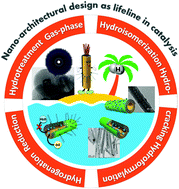Clay nanotube-metal core/shell catalysts for hydroprocesses†
Abstract
Catalytic hydroprocesses play a significant role in oil refining and petrochemistry. The tailored design of new metal nanosystems and optimization of their support, composition, and structure is a prospective strategy for enhancing the efficiency of catalysts. Mesoporous support impacts the active component by binding it to the surface, which leads to the formation of tiny highly dispersed catalytic particles stabilized from aggregation and with minimized leaching. The structural and acidic properties of the support are crucial and determine the size and dispersion of the active metal phase. Currently, research efforts are shifted toward the design of nanoscale porous materials, where homogeneous catalysts are displaced by heterogeneous. Ceramic materials, such as 50 nm diameter natural halloysite nanotubes, are of special interest for this. Much attention to halloysite clay is due to its tubular structure with a hollow 10–15 nm diameter internal cavity, textural characteristics, and different chemical compositions of the outer/inner surfaces, allowing selective nanotube modification. Loading halloysite with metal particles or placing them outside the tubes provides stable and efficient mesocatalysts. The low cost of this abundant nanoclay makes it a good choice for the scaled-up architectural design of core–shell catalysts, containing active metal sites (Au, Ag, Pt, Ru, Co, Mo, Fe2O3, CdS, CdZnS, Cu–Ni) located inside or outside the tubular template. These alumosilicate nanotubes are environment-friendly and are available in thousands of tons. Herein, we summarized the advances of halloysite-based composite materials for hydroprocesses, focusing on the selective binding of metal particles. We analyze the tubes’ morphology adjustments and size selection, the physicochemical properties of pristine and modified halloysite (e.g., acid-etched or silanized), the methods of metal clusters formation, and their localization. We indicate prospective routes for the architectural design of stable and efficient nanocatalysts based on this safe and natural clay material.



 Please wait while we load your content...
Please wait while we load your content...
